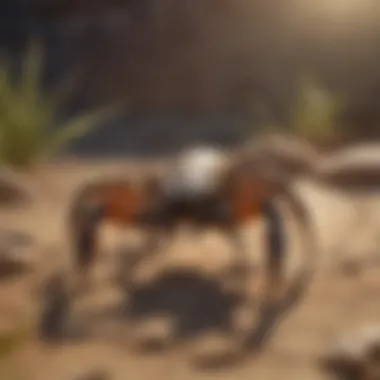Unveiling the Enigmatic World of Scorpions: Discovering the Secrets of These Mysterious Creatures


Introduction
This article embarks on a fascinating journey into the mysterious world of scorpions, unveiling hidden facets of their behavior, anatomy, and habitat. Delving deep into their unique hunting strategies and intriguing adaptations, readers will gain a profound understanding of these cryptic arachnids. Prepare to explore the enigmatic realms of scorpions as we dissect their mysteries and disclose their secrets.
Understanding Scorpions at a Deeper Level
To comprehend the essence of scorpions, it's crucial to analyze their behavior, anatomy, and preferred habitats. Examining their hunting techniques and unique adaptations will shed light on their survival strategies in diverse environments. Dive into the distinct characteristics that define scorpions, exploring how these elements play a pivotal role in their existence.
Navigating the Intricacies of Scorpion Behavior
Unravel the intricate behaviors of scorpions, from their hunting rituals to their reproductive patterns. Understanding how scorpions interact with their environment and prey is paramount in decoding their elusive nature. Uncover the nuances of scorpion behavior to reveal the mechanisms behind their survival instincts and intricate social structures.
Analyzing Scorpion Anatomy and Adaptations
Explore the anatomical features and specialized adaptations that empower scorpions to thrive in varying ecological niches. From their sensory organs to their venomous stingers, each aspect of scorpion anatomy serves a distinct purpose in their survival. Delve into the evolutionary adaptations that have sculpted scorpions into formidable predators and resilient survivors.
Exposing Scorpions' Habitat Preferences
Investigate the diverse habitats that scorpions inhabit, ranging from desolate deserts to lush rainforests. Gain insight into the environmental factors that influence scorpion distribution and behavior, illuminating the symbiotic relationships they form within their ecosystems. Uncover the secrets of scorpions' preferred habitats and the ecological roles they fulfill.
Conclusion
As we conclude this captivating exploration of scorpions, we have unveiled the veil of mystery surrounding these enigmatic creatures. By dissecting their behavior, anatomy, and habitat, we have gained a profound appreciation for the intricate complexities of scorpions. Join us in deciphering the enigmas of scorpions as we continue to unravel their secrets and celebrate their profound impact on the natural world.
Introduction to Scorpions
In this article, the 'Introduction to Scorpions' serves as the foundational pillar that sets the stage for unveiling the secrets of these enigmatic creatures. Highlighting the key points that will be explored, this section provides a comprehensive overview of the vital aspects of scorpions – ranging from their behavior, anatomy, to their habitat. By delving into the introductory realm of scorpions, readers are primed to embark on a journey of discovery and enlightenment regarding these elusive arachnids.
An Overview of Scorpions
Defining Characteristics
The 'Defining Characteristics' segment delves into the core attributes that distinguish scorpions from other arachnids. By elucidating the specific features that make scorpions unique, such as their segmented bodies, pair of pincers, and venomous stinger at the end of their tail, this section underscores the quintessence of scorpion anatomy. Understanding these defining traits is crucial for comprehending the evolutionary adaptations that have allowed scorpions to thrive in diverse environments, making this section indispensable for shedding light on the essence of scorpions within the context of this article. While their venom can be a potent defense mechanism, it also plays a critical role in subduing prey, rendering this characteristic a focal point of intrigue and study.


Evolutionary History
The 'Evolutionary History' module surveys the fascinating journey of scorpions through time, tracing their lineage back millions of years. Exploring the evolutionary adaptations that have shaped scorpions into the formidable predators they are today, this section unveils the complex interplay between genetic factors and environmental pressures that have sculpted the scorpions we recognize. By unraveling the ancient origins of scorpions and their transitions across geologic eras, readers are offered a glimpse into the intricate tapestry of evolution that defines these intriguing creatures. An in-depth exploration of their evolutionary trajectory provides essential context for appreciating the resilience and adaptability that characterize scorpions.
Global Distribution
The 'Global Distribution' component maps out the expansive territory that scorpions inhabit across the world, showcasing their adaptability to diverse climates and terrains. From arid deserts to lush rainforests, scorpions have made their mark in nearly every corner of the globe, illustrating their ability to thrive in varied ecosystems. This section illuminates the geographic spread of scorpions and delves into the factors that influence their distribution, shedding light on the interconnected relationship between scorpions and the environments they inhabit. By exploring the nuances of global distribution, readers gain insights into the versatile nature of scorpions and the ecological roles they fulfill within different landscapes.
Behavioral Patterns and Adaptations
In this article, the Behavioral Patterns and Adaptations of scorpions take center stage, offering a profound look into the intricacies of these elusive creatures. Their behavior and adaptations are crucial elements that shape their survival and interaction within their ecosystems. Understanding how scorpions hunt, defend themselves, and reproduce provides invaluable insights into their evolutionary success and ecological impact.
Hunting Strategies
Ambush Techniques:
Ambush Techniques represent a fascinating aspect of scorpion hunting behavior. These stealthy maneuvers allow scorpions to patiently wait for unsuspecting prey, demonstrating their strategic prowess in securing meals. The key characteristic of Ambush Techniques lies in the scorpion's ability to remain motionless for extended periods, relying on camouflage and patience to capture their target. This technique is a popular choice for this article due to its significance in showcasing the predator-prey dynamics of scorpions. The unique feature of Ambush Techniques is their efficiency in conserving energy while maximizing hunting success. However, an inherent disadvantage is the reliance on favorable conditions for successful ambushes.
Venomous Strikes:
Another critical hunting strategy employed by scorpions is their Venomous Strikes. Delving into this aspect unveils the powerful mechanisms scorpions use to immobilize and subdue prey. The key characteristic of Venomous Strikes is the delivery of potent venom through specialized stingers, ensuring swift incapacitation of victims. This strategy is beneficial in aiding scorpions to hunt effectively and overpower larger adversaries. The unique feature of Venomous Strikes lies in the diverse range of toxins employed by different scorpion species, tailored to their specific prey preferences. However, a potential disadvantage is the risk of expending valuable venom resources on unsuccessful strikes.
Survival Mechanisms
Camouflage Abilities:
Scorpions' Camouflage Abilities play a vital role in their survival within diverse environments. By blending seamlessly with their surroundings, scorpions evade detection from predators and prey alike, highlighting the importance of this adaptation in their daily activities. The key characteristic of Camouflage Abilities is the ability to adjust skin pigmentation to match the immediate environment, enhancing their chances of remaining hidden. This choice for the article is significant as it sheds light on the evolutionary advantage of camouflage in scorpions. The unique feature of Camouflage Abilities is their non-invasive nature, allowing scorpions to conserve energy by avoiding unnecessary movement. An advantage lies in the enhanced protection against predators, while a potential disadvantage could be reduced visibility for mating rituals.
Defense Mechanisms:
Expanding on scorpions' Defense Mechanisms offers a glimpse into their arsenal of protective adaptations. From defensive postures to venomous deterrents, scorpions have evolved diverse strategies to ward off threats. The key characteristic of Defense Mechanisms is the multifaceted approach scorpions employ to deter predators and prevent harm, showcasing their resilience in challenging environments. This choice for the article is crucial as it underscores the intricate balance between offense and defense in scorpions' survival strategies. The unique feature of Defense Mechanisms is their immediate response to perceived dangers, demonstrating scorpions' agility in combat situations. While an advantage is the rapid deployment of defenses, a potential disadvantage could be the energy expenditure required to sustain defensive actions.
Reproductive Behavior


Mating Rituals:
Exploring the Mating Rituals of scorpions unveils the complex courtship behaviors that precede reproduction. From intricate dances to chemical signaling, scorpions engage in elaborate displays to attract potential mates. The key characteristic of Mating Rituals lies in the communication mechanisms scorpions use to convey genetic fitness and mating readiness, essential for successful reproduction. This choice for the article provides a glimpse into the behavioral intricacies that shape scorpions' mating preferences. The unique feature of Mating Rituals is their species-specific variations, reflecting the diverse evolutionary pathways scorpions have undertaken for reproductive success. An advantage includes the establishment of strong genetic offspring, while a potential disadvantage could be the vulnerability of exposed individuals during courtship displays.
Parental Care:
Delving into scorpions' Parental Care sheds light on the rare instances of maternal investment found in arachnids. From protecting offspring to providing sustenance, scorpions exhibit varying degrees of parental care across different species. The key characteristic of Parental Care is the dedication shown by some scorpion species in safeguarding their young, illustrating the importance of nurturance in ensuring offspring survival. This choice for the article emphasizes the significance of parental investment in shaping scorpion reproductive success. The unique feature of Parental Care is the limited presence of such behavior among arachnids, highlighting the evolutionary significance of this adaptation. While an advantage includes increased survival rates for offspring, a potential disadvantage could be the diversion of resources from personal survival to parental duties.
Ecological Role of Scorpions
In exploring the topic of the Ecological Role of Scorpions, we uncover a crucial aspect of their existence within various ecosystems. Scorpions play a significant role in maintaining ecological balance and diversity. These arachnids act as important predators, controlling insect populations and contributing to the regulation of prey species. By preying on smaller animals, scorpions help in controlling potential pest outbreaks, which is vital for the overall health of ecosystems. Additionally, as prey themselves for larger predators, they form part of a complex food web, showcasing the interconnectedness of species in nature.
Predatory Relationships
Prey Interactions
Prey interactions demonstrate the intricate dynamics within scorpion ecosystems. Scorpions have evolved various hunting techniques adapted to capture different prey effectively. Their venomous strikes are finely tuned to subdue their chosen targets, highlighting the precise predatory nature of these creatures. The ability to sense and hunt specific prey showcases the effectiveness of scorpions as specialized predators. Although their methods may seem ruthless, they serve an essential purpose in the ecological balance.
Role in Food Chains
Scorpions' role in food chains is integral to understanding their ecological impact. As predators, they occupy a crucial position in various food webs, contributing to energy transfer and nutrient cycling. By regulating insect populations, scorpions help maintain biodiversity and prevent unchecked population growth of certain species. Their presence influences the abundance and behavior of prey species, creating a ripple effect throughout the ecosystem. Scorpions' position as both hunters and potential prey underscores their significance in ecosystem dynamics.
Habitat Preferences
Adaptation to Environments
Scorpions' adaptation to environments showcases their resilience and ability to thrive in a variety of habitats. From deserts to forests, scorpions have evolved specific physical and behavioral characteristics to suit diverse landscapes. Their adaptability to different climates and terrains demonstrates their versatility as arachnids. The ability to thrive in harsh environments speaks to the evolutionary success of scorpions as resilient species capable of overcoming environmental challenges.
Climate Influence
Scorpions' sensitivity to climate influences their distribution and behavior patterns. Climate factors such as temperature and humidity play a significant role in shaping scorpion habitats and activities. Changes in climate can have cascading effects on scorpion populations, affecting their reproduction, feeding habits, and overall survival. Understanding the interplay between scorpions and climate sheds light on the delicate balance within ecosystems and the need to consider environmental factors in conservation efforts.
Conservation Concerns


Threats to Scorpion Populations
Threats to scorpion populations pose challenges to their survival and the maintenance of ecological balance. Factors such as habitat loss, pollution, and climate change contribute to declining scorpion populations in various regions. Fragmentation of habitats and human encroachment further exacerbate the threats faced by these creatures, jeopardizing their long-term viability. Mitigating these threats requires a comprehensive understanding of the factors endangering scorpions and implementing targeted conservation strategies.
Protection Strategies
Protection strategies aim to safeguard vulnerable scorpion populations and their habitats. Conservation efforts focus on preserving critical habitats, reducing human-wildlife conflicts, and raising awareness about the importance of scorpions in ecosystems. Establishing protected areas and implementing sustainable management practices are integral to ensuring the continued survival of scorpions. By prioritizing their protection, we uphold the ecological balance and biodiversity supported by these enigmatic arachnids.
Research and Study Approaches
In the intricate realm of scorpions, understanding their essence requires a dedicated exploration of research and study approaches. This article delves into the significance of these approaches specifically tailored to shed light on the elusive nature of these creatures. By employing meticulous methodologies and cutting-edge techniques, researchers can unravel the mysteries that clothe these enigmatic arachnids. Research and study approaches serve as the cornerstone of unveiling the secrets of scorpions, offering invaluable insights into their behavior, anatomy, and habitat.
Field Observations
Behavioral Studies
Behavioral studies stand at the forefront of scorpion research, providing a comprehensive analysis of their actions and interactions. By scrutinizing the behavioral patterns of scorpions in their natural habitat, researchers can decipher the nuances of their hunting strategies and survival mechanisms. The key characteristic of behavioral studies lies in their ability to capture the intricacies of scorpion behavior, offering a holistic view of their adaptive traits. Despite the challenges of observing these elusive creatures, behavioral studies remain a pivotal choice for this article due to their ability to unravel the enigmatic nature of scorpions. While time-consuming and weather-dependent, behavioral studies provide invaluable data essential for understanding scorpion dynamics.
Population Surveys
Population surveys play a crucial role in assessing the abundance and distribution of scorpions in different ecosystems. By conducting systematic surveys across varied habitats, researchers can pinpoint population trends and ecological preferences of scorpions. The key characteristic of population surveys lies in their ability to quantify scorpion populations and identify potential conservation areas. This method is a popular choice for this article as it provides essential data on scorpion demographics and spatial distribution. However, logistical challenges and limited accessibility to certain regions can pose as disadvantages, impacting the thoroughness of population surveys.
Laboratory Experiments
Venom Analysis
Venom analysis stands as a fundamental aspect of scorpion research, delving into the intricate chemistry of their venomous arsenal. By dissecting the composition and effects of scorpion venom, researchers can unravel its biological significance and potential applications. The key characteristic of venom analysis lies in its ability to uncover the toxic components of scorpion venom, aiding in medical research and pharmaceutical advancements. This method proves beneficial for this article as it offers a deeper understanding of scorpion physiology and ecological role. Despite the complexities involved in venom analysis, its insights provide invaluable knowledge that contributes significantly to scorpion studies.
Genetic Research
Genetic research opens a window into the evolutionary history and genetic makeup of scorpions, unraveling their unique adaptations and phylogenetic relationships. By analyzing the DNA sequences of scorpions, researchers can trace their origins and genetic diversity across different species. The key characteristic of genetic research lies in its ability to uncover the genetic mechanisms driving scorpion diversity and adaptation. This method is a popular choice for this article due to its capacity to provide insights into scorpion evolution and speciation. Despite the challenges in genetic analysis such as sequencing complexities, the benefits outweigh the limitations by offering crucial data for understanding scorpion genetic dynamics.
Technological Advancements
Tracking Devices
Tracking devices revolutionize the study of scorpions by enabling researchers to monitor their movements and behavioral patterns in real-time. By attaching tracking devices to scorpions, researchers can gather valuable data on their foraging behaviors and habitat preferences. The key characteristic of tracking devices lies in their ability to provide detailed insights into scorpion ecology and spatial dynamics. This innovative tool proves beneficial for this article by enhancing the precision and depth of scorpion field studies. Despite possible limitations such as device accuracy and battery life, tracking devices offer a valuable means of elucidating the cryptic behaviors of scorpions.
Microscopic Imaging
Microscopic imaging offers a glimpse into the intricate structures and details of scorpions, unveiling their anatomy at a microscopic level. By utilizing advanced imaging techniques, researchers can visualize the internal morphology and physiological adaptations of scorpions with unprecedented clarity. The key characteristic of microscopic imaging lies in its ability to reveal the subtle features and mechanisms of scorpion biology, enhancing our understanding of their form and function. This method is a crucial choice for this article as it provides a deeper insight into scorpion anatomy and evolutionary adaptations. Despite potential limitations such as resolution constraints, microscopic imaging offers a valuable tool for exploring the hidden wonders of scorpions.







